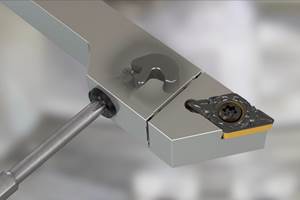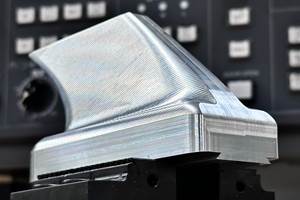Harnessing the Holding Force
Inserts engineered to augment the vise’s effectiveness allow work to be held rigidly on a tiny clamping area.
Share





Milling and turning inserts have the shapes they do because the insert’s geometry affects chip formation, thereby affecting the performance of the cut. Insert forms are strategically designed to direct cutting forces in the most effective way.
Could inserts also be strategically designed to direct the force of workholding?
That is the idea behind the “SinterGrip” vise jaws from OML, which use carbide inserts to grip the work. Each serrated insert slightly penetrates the work, while also featuring an engineered form that directs clamping force in a way that improves the vise’s hold on the workpiece. The result is rigid clamping from a system that holds only a tiny edge of the part—just 3.5 millimeters. One of the most important benefits of achieving the secure hold on this small region is more productive five-axis machining.
Lexair supplies the vise jaw system (see Editor’s Note). Steve Breslin, national sales manager for Lexair, describes the connection to five-axis machining. Part of the value of five axes is the chance to machine various faces of the part in a single cycle, he says, but this inherently means that those faces have to be exposed for machining. Clamping on a small area, to get the workholding out the way, typically translates to low holding force. Thus, five-axis machining frequently ends up being delicate machining.
By contrast, the video above of heavy milling in steel illustrates the cutting that is possible using this same small clamping area. The SinterGrip inserted jaws achieve the strong hold for this heavy milling in various ways.
The hold partly comes from penetration. The serrated inserts slightly press into the part upon clamping, to a depth of no more than 0.5 mm (usually much less). In some applications, this impression provides an added benefit, because it creates location references for re-setting the work for re-machining.
Another component of the rigid clamping is the insert’s form. Just like a cutting insert, the shape of this insert aims to channel forces to the process’s advantage. Different angles above and below the serrations produce a resultant force that directs the work downward toward the machine table. Negative angles on the insert faces that meet the pocket also produce a downward-directed force. These effects make better use of the vise’s holding force than straight jaw faces that simply direct the force into a squeeze applied parallel to the machine table.
The inserts come with parallels as part of a jaw system that can be installed on most mechanical or hydraulic vises. Different clamping inserts are designed for different part materials, varying in the number and design of serrations, as well as in the coating applied to the insert. For holding standard steel, the carbide inserts are coated with TiN, while inserts for aluminum are coated with CrN/NbN and inserts for titanium and hardened steels are coated with TiAlCn. Replacing worn inserts is easy, says Mr. Breslin—though he points out that since the inserts are holding the work instead of cutting it, there is no reason to expect that they will ever wear out.
Related Content
Quick-Change Tool Heads Reduce Setup on Swiss-Type Turning Centers
This new quick-change tooling system enables shops to get more production from their Swiss turning centers through reduced tool setup time and matches the performance of a solid tool.
Read MoreCustom Workholding Principles to Live By
Workholding solutions can take on infinite forms and all would be correct to some degree. Follow these tips to help optimize custom workholding solutions.
Read MoreShop Reclaims 10,000 Square Feet with Inventory Management System
Intech Athens’ inventory management system, which includes vertical lift modules from Kardex Remstar and tool management software from ZOLLER, has saved the company time, space and money.
Read MoreOrthopedic Event Discusses Manufacturing Strategies
At the seminar, representatives from multiple companies discussed strategies for making orthopedic devices accurately and efficiently.
Read MoreRead Next
AMRs Are Moving Into Manufacturing: 4 Considerations for Implementation
AMRs can provide a flexible, easy-to-use automation platform so long as manufacturers choose a suitable task and prepare their facilities.
Read MoreMachine Shop MBA
Making Chips and 91ÊÓƵÍøÕ¾ÎÛ are teaming up for a new podcast series called Machine Shop MBA—designed to help manufacturers measure their success against the industry’s best. Through the lens of the Top Shops benchmarking program, the series explores the KPIs that set high-performing shops apart, from machine utilization and first-pass yield to employee engagement and revenue per employee.
Read More





















